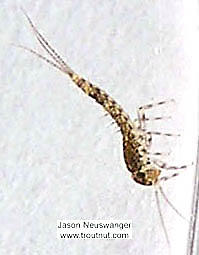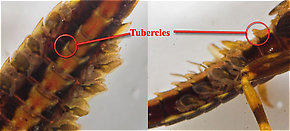Blog & Latest Updates
Fly Fishing Articles
Insects by Common Name


Animal Phylum Arthropoda (Arthropods)
Taxonomic Navigation -?-
Kingdom
Animalia (Animals)
» Phylum Arthropoda (Arthropods)
| Class in Arthropoda | ||
| ArachnidaMites and Spiders | 0 | 1 |
| CollembolaSpringtails | 0 | 0 |
| Crustacea-MalacostracaCrayfish, Scuds, and Sowbugs | 0 | 10 |
| Crustacea-Maxillopoda | 0 | 0 |
| InsectaInsects | 0 | 114 |
Common Name
| Match | Common Name |
| Arthropods |
This is page 27 of specimens of Arthropoda. Visit the main Arthropoda page for:
- The behavior and habitat of Arthropoda.
- 122 underwater pictures of Arthropoda.
Pictures of 1244 Arthropod Specimens:
Sialis Alderfly Larva View 4 Pictures
View 4 Pictures
 View 4 Pictures
View 4 PicturesCollected February 5, 2004 from unknown in Wisconsin
Added to Troutnut.com by Troutnut on January 25, 2006
Added to Troutnut.com by Troutnut on January 25, 2006
Trichoptera (Caddisflies) Caddisfly Larva View 4 Pictures
View 4 Pictures
 View 4 Pictures
View 4 PicturesCollected February 5, 2004 from unknown in Wisconsin
Added to Troutnut.com by Troutnut on January 25, 2006
Added to Troutnut.com by Troutnut on January 25, 2006
Baetidae (Blue-Winged Olives) Mayfly Nymph View 4 Pictures
View 4 Pictures
 View 4 Pictures
View 4 PicturesCollected January 13, 2004 from the Namekagon River in Wisconsin
Added to Troutnut.com by Troutnut on January 25, 2006
Added to Troutnut.com by Troutnut on January 25, 2006
Eurylophella (Chocolate Duns) Mayfly Nymph View 4 PicturesClose examination under a microscope easily showed abdominal tubercles (
View 4 PicturesClose examination under a microscope easily showed abdominal tubercles ( Tubercle: Various peculiar little bumps or projections on an insect. Their character is important for the identification of many kinds of insects, such as the nymphs of Ephemerellidae mayflies.).
Tubercle: Various peculiar little bumps or projections on an insect. Their character is important for the identification of many kinds of insects, such as the nymphs of Ephemerellidae mayflies.).
 View 4 PicturesClose examination under a microscope easily showed abdominal tubercles (
View 4 PicturesClose examination under a microscope easily showed abdominal tubercles (
A few (not all) of the abdominal tubercles on this Ephemerella needhami nymph are circled. They are especially large in this species.
Collected January 31, 2004 from unknown in Wisconsin
Added to Troutnut.com by Troutnut on January 25, 2006
Added to Troutnut.com by Troutnut on January 25, 2006
Geometridae (Inchworms) Moth Larva View 6 PicturesI caught this inchworm lowering itself to the surface of a trout stream from its silk thread. I saw a couple others floating on the surface, so it's likely the trout were familiar with them.
View 6 PicturesI caught this inchworm lowering itself to the surface of a trout stream from its silk thread. I saw a couple others floating on the surface, so it's likely the trout were familiar with them.
 View 6 PicturesI caught this inchworm lowering itself to the surface of a trout stream from its silk thread. I saw a couple others floating on the surface, so it's likely the trout were familiar with them.
View 6 PicturesI caught this inchworm lowering itself to the surface of a trout stream from its silk thread. I saw a couple others floating on the surface, so it's likely the trout were familiar with them.Collected May 29, 2007 from Brodhead Creek in Pennsylvania
Added to Troutnut.com by Troutnut on June 4, 2007
Added to Troutnut.com by Troutnut on June 4, 2007
Leptophlebia cupida (Borcher Drake) Mayfly Nymph View 4 PicturesThis one survived several days in an aquarium before being photographed. Leptophlebia cupida is known as a durable species.
View 4 PicturesThis one survived several days in an aquarium before being photographed. Leptophlebia cupida is known as a durable species.
I'm trying to try a similar specimen (link to the next specimen) and see how that works.
 View 4 PicturesThis one survived several days in an aquarium before being photographed. Leptophlebia cupida is known as a durable species.
View 4 PicturesThis one survived several days in an aquarium before being photographed. Leptophlebia cupida is known as a durable species.I'm trying to try a similar specimen (link to the next specimen) and see how that works.
Collected February 4, 2004 from the Namekagon River in Wisconsin
Added to Troutnut.com by Troutnut on January 25, 2006
Added to Troutnut.com by Troutnut on January 25, 2006
Ephemerella invaria (Sulphur Dun) Mayfly Nymph View 4 Pictures
View 4 Pictures
 View 4 Pictures
View 4 PicturesCollected January 31, 2004 from unknown in Wisconsin
Added to Troutnut.com by Troutnut on January 25, 2006
Added to Troutnut.com by Troutnut on January 25, 2006
Ephemerella subvaria (Hendrickson) Mayfly Nymph View 4 PicturesHere's one of the darkest E. subvaria nymphs I've seen.
View 4 PicturesHere's one of the darkest E. subvaria nymphs I've seen.
 View 4 PicturesHere's one of the darkest E. subvaria nymphs I've seen.
View 4 PicturesHere's one of the darkest E. subvaria nymphs I've seen.Collected February 7, 2004 from unknown in Wisconsin
Added to Troutnut.com by Troutnut on January 25, 2006
Added to Troutnut.com by Troutnut on January 25, 2006
Isonychia bicolor (Mahogany Dun) Mayfly Nymph View 4 Pictures
View 4 Pictures
 View 4 Pictures
View 4 PicturesCollected February 7, 2004 from the Namekagon River in Wisconsin
Added to Troutnut.com by Troutnut on January 25, 2006
Added to Troutnut.com by Troutnut on January 25, 2006
Female Maccaffertium pudicum Mayfly Spinner View 6 PicturesThis one may look a bit strange, because one of her main wings came off in my container.
View 6 PicturesThis one may look a bit strange, because one of her main wings came off in my container.
 View 6 PicturesThis one may look a bit strange, because one of her main wings came off in my container.
View 6 PicturesThis one may look a bit strange, because one of her main wings came off in my container.Collected May 28, 2007 from Mystery Creek #42 in Pennsylvania
Added to Troutnut.com by Troutnut on June 4, 2007
Added to Troutnut.com by Troutnut on June 4, 2007
Top 10 Fly Hatches
Top Gift Shop Designs
Eat mayflies.
Top Insect Specimens
Miscellaneous Sites
Troutnut.com is copyright © 2004-2024 Jason
Neuswanger (email Jason). See my FAQ for information about use of my images.
 privacy policy
privacy policy
